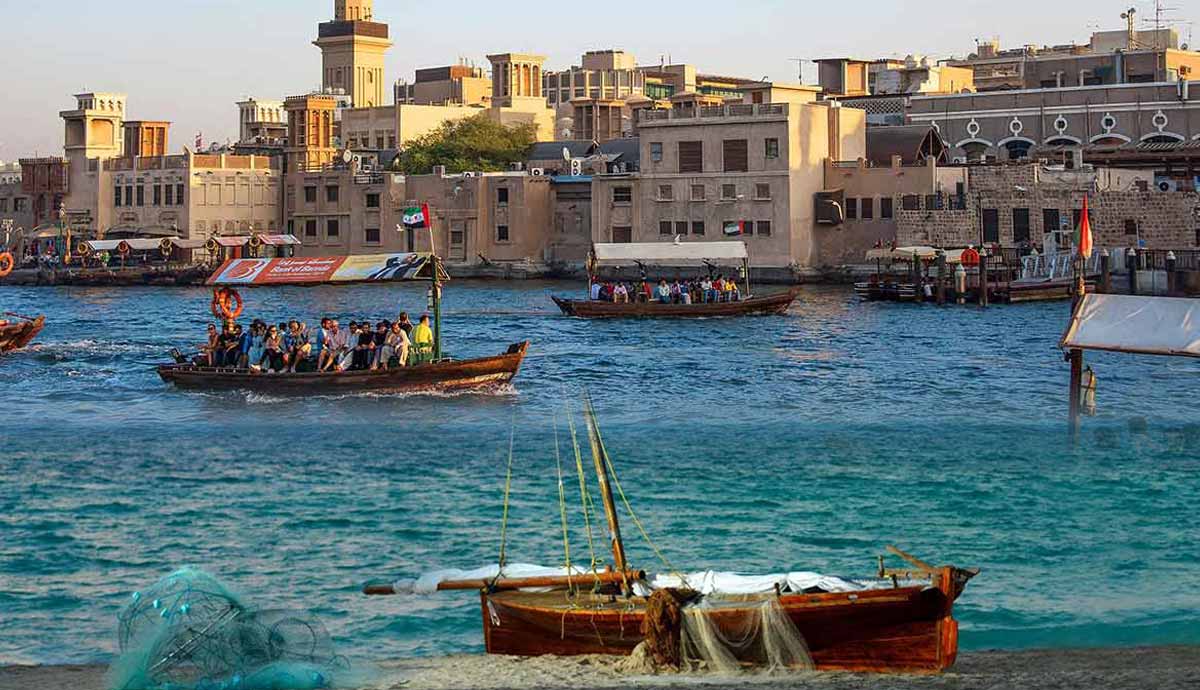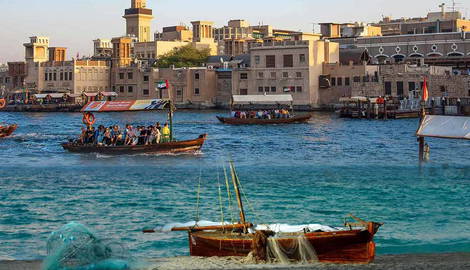
Dubai may be best known for its glitzy, glamourous streets strewn with super-luxury hotels and traversed by sleek supercars, but there is more to the United Arab Emirates’ capital than first meets the eye. On the shores of Dubai Creek, Deira and Bur Dubai (Old Dubai) are the city’s historic center. It wasn’t until the 1960s that Dubai began to grow into the megacity it is today, but it existed for centuries before this. A visit to Old Dubai provides a fascinating insight into the sleepy fishing village it once was.
The Origins of Dubai

Little is known about the city’s ancient history. It is likely that the first human activity in the area dates back to the Ubaid Period which started in around 5500 BCE. The first recorded mention of Dubai was by the geographer Abu Abdullah al-Bakri, who noted the existence of a settlement here in his 1095 CE book, Book of Geography. His mention was a fleeting one, and there is no surviving record after this until 1580, when Gasparo Balbi noted that Dubai was a trading hub for the pearling industry in his memoir Voyage to the Oriental Indies. The Persian Gulf was a hotspot for pearl diving where slave-labor was used to extract the gems from wild mollusks on the seabed.
Dubai was slow to grow and it was only in the 18th century that it came to be established as a permanent village. Members of the Bani Yas tribes moved to Dubai for pearling and by 1822, around 800 members of the tribe had made their homes on the banks of Dubai Creek. In 1833, infighting among the sects of the tribe led to the Al Bu Falasah leaving their land in Abu Dhabi to settle in Dubai.
This move from Abu Dhabi was led by two tribal leaders, Obeid bin Saeed and Maktoum al Butti. Saeed died just three years after relocating to Dubai, leaving Maktoum al Butti as the Emirate’s sole ruler. The House of Maktoum rules Dubai to this day. Sheikh Mohammed bin Rashid Al Maktoum, a seventh generation descendent of al Butti, currently holds the post, as well as being the UAE’s Prime Minister and Vice President.
The Importance of Dubai Creek

Just as London grew around the Thames and Washington DC around the Potomac, Dubai’s creek was integral to its development. Not only was it a major source of pearls and fish, but the creek provided a means to trade.
The Al Bu Falasah settlers made a home on the western banks of the Creek in what is now known as Bur Dubai. Meanwhile, on the eastern banks, in an area known as Deira, another small fishing village was established in the mid-17th century.
Dubai Creek both divided and connected the two settlements. Stretching several miles inland, the overland journey was a long and treacherous one. But this calm, narrow passage of water was easy to cross by boat. Local workers constructed small, basic wooden boats which became known as abras which they used to carry goods and passengers across the creek.
When a smallpox epidemic broke out in Bur Dubai, abras provided a lifeline means of escape. Residents traveled across the creek and relocated to Deira, causing significant growth and development on the eastern shore.
As trade links began to grow, larger dhow boats started using Dubai Creek as a safe anchorage enabling trade with as far afield as India and East Africa. With no other port in the area, it was the creek that enabled Dubai to grow from a small, insignificant fishing village to a hub of international trade. Souks were established in both Bur Dubai and Deira, with the tiny abras once again providing a means to get traders and their goods between the souks. It wasn’t until 1963 that the first bridge across the creek was built.
Growth to a Megacity

With the introduction of far cheaper cultured pearls in the 1930s, Dubai’s pearling industry fell into a rapid decline. Elsewhere in the region, oil discoveries provided new opportunities for growth and brought with them significant wealth. But in Dubai, oil wouldn’t be struck until 1966 and the city fell into poverty.
While these were hard times for the residents of Deira and Bur Dubai who had relied on the trade, then-ruler Sheikh Rashid bin Saeed Al Maktoum recognized the importance of the creek and launched a plan to increase its capacity. In 1961, it was dredged to allow larger vessels to anchor in Dubai.
This enabled Dubai to establish itself as a major outpost for the gold trade, bringing a reprise to the city’s economy. Gold would be imported from London and traded in the souks of Bur Dubai and Deira, with a dedicated gold souk being set up in the latter. The city’s merchants would carry the gold by dhow into the waters of the Indian Ocean where it was passed onto Indian buyers. The import of the precious metal was banned in India, but Dubai’s traders got around this by handing over the goods in international waters.
With the oil-driven wealth of the late-1960s, construction began on a new, purpose-built port in Jebel Ali to the southwest of the city. It was opened by Queen Elizabeth II in 1979 and slowly, Dubai Creek’s significance began to fade. Port Saeed, on the Deira side of the creek, remained in operation, however.

In recent years, further development has seen extensions to the creek built in 2007 and 2016. The creek now extends in a semi-circle around the city, with a second mouth in the modern Jumeirah district. There are now four bridges crossing it, with a further three planned, but abras still carry passengers and goods across the creek every few minutes.
Dubai may have grown beyond Bur Dubai and Deira, but these settlements and their creek remain an integral part of the city’s existence.
Visiting Old Dubai

Old Dubai is a destination in its own right but also makes for an ideal culture-ridden day trip from the resorts of the modern city. When visiting, it’s only right to experience both Bur Dubai and Deira, two distinct neighborhoods with very different vibes. While the modern traveler has the option of taking a taxi or metro between them, the best way to do it is the old way: by abra. These depart frequently from the Abra Stations on either side of the creek and cost 1 AED, payable in cash only.
Bur Dubai

Bur Dubai, the closest to the modern city center, is home to some fascinating and beautifully preserved historic districts. Al Fahidi Historic District was built in the early-20th century by Persian merchants looking to benefit from the pearl trade. When the gold trade began to fade in the 1970s, the area fell into disrepair, and in 1980, the government announced plans to demolish it. Thanks to the efforts of local residents, and with the help of the then-Prince of Wales, these plans were shelved, and it has been lovingly restored.

Within Al Fahidi, the Sheikh Mohammed Centre for Cultural Understanding was opened in 1995 to help keep traditional Emirati culture alive as Dubai became heavily influenced by outside cultures. Along with a museum, they provide guided tours of the Historic District and Jumeirah Mosque.
Just along the creek from Al Fahidi, a more recently restored heritage area is Al Seef. This was where the pearl trade was centered. While it is gradually becoming more commercialized in parts, much of the area is given over to maintaining traditions — albeit with the addition of a Starbucks. Many of the buildings in the preserved old village are part of the Al Seef Heritage Hotel, Curio Collection by Hilton, which provides a great alternative to the luxury resorts elsewhere in Dubai, offering traditionally furnished accommodation in the original buildings of Al Seef.
Deira

Across the creek from modern Dubai, Deira is just as much of a trading hub as ever. Modern business developments, such as the Rolex Tower sit hand-in-hand with age-old souks. The souks begin at the Abra Station and extend all the way to Port Rashid on the Persian Gulf.
The Grand Souk, also known as the Old Souk, is the busiest spot, selling everything imaginable. Next door is Dubai Spice Souk, where the smells are the only upselling required. The Gold Souk is a nod to Deira’s past, with other souks dedicated to carpets, perfumes, and homeware. If you can get past the pushy sales tactics and overinflated prices for tourists, the Deira souk is an unforgettable experience.
Another nod to Dubai’s heritage is the Pearl Museum, which houses a collection of these natural wonders along with original tools and diving equipment. Alongside Deira’s history, a visit to the Clocktower is a must. A futuristic building, it was built to commemorate the building of Al Maktoum Bridge in 1963.
Why Visit?

The old and new of Dubai couldn’t be more of a contrast. Whether you’ve been putting off visiting Dubai as a history-lover who can’t stand the concept of modern resorts built on reclaimed land, or you love the city for exactly that reason, a visit to Old Dubai is well worth it.
Dubai may have been built by oil, but it was founded by Dubai Creek. Oil production peaked in 1991 and reserves have been dwindling ever since. The creek, the abras, and the souks are here to stay.
Just as much as Bur Dubai and Deira shaped the city we see today, they still play an important role in its existence which runs deep beyond tourism. Old Dubai is anything but confined to the history books.










